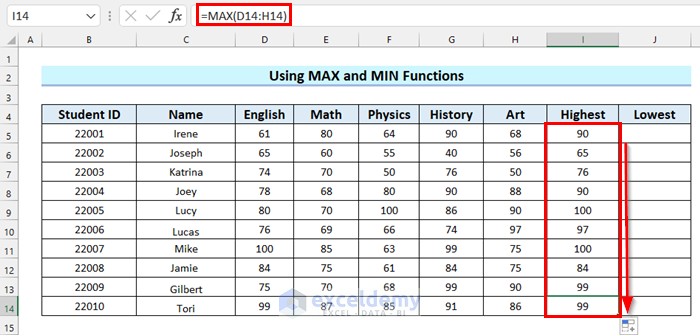5 Ways to Create a Result Sheet in Excel

🌟 Welcome to our guide on creating dynamic and efficient result sheets in Microsoft Excel! Whether you're a teacher, student, HR professional, or just someone who loves to keep things organized, Excel provides robust tools for managing and analyzing data effectively. Let's dive into five different methods to craft these result sheets.
Method 1: Basic Table Layout with Formulas

Start with the simplest approach for beginners to craft a result sheet:
- Create the Header: Enter headers like “Name,” “Subject,” “Marks Obtained,” and “Total Marks.”
- Data Entry: Fill in the names and respective marks for each student.
- Use Formulas:
- Use
=SUM(A2:A5)to calculate the total marks for each student where A2:A5 are mark columns. - For percentages, use
=(B2/B4)*100to calculate the percentage where B2 is marks obtained and B4 is total marks.
- Use
- Formatting: Highlight important cells or columns using conditional formatting for quick visual analysis.
📝 Note: Using =$A$2:$A$5 makes cells absolute references, ensuring the formula doesn’t change when you copy it across rows or columns.
Method 2: Advanced Use of Functions for Dynamic Sheets

For more intricate and responsive sheets, dive into Excel’s advanced functions:
- INDEX & MATCH: For retrieving student marks based on their name or subject.
- VLOOKUP or HLOOKUP: These functions facilitate lookup operations for larger datasets.
- Data Validation: To limit input to specific options or ranges, enhancing data integrity.
- Conditional Formatting: Enhance visibility of results through automatic color coding based on performance.
Method 3: Using Excel Tables for Sortable Results

Excel tables provide a dynamic framework for managing data:
- Convert your data into a table with Insert > Table and apply styles.
- This allows for easy sorting, filtering, and dynamic range expansion.
- Formulas inside tables auto-update when rows are added or deleted.
Method 4: Integration with External Data for Real-Time Updates

Enhance your result sheets with real-time data integration:
- Power Query: Connect to external databases or files to pull in data automatically.
- Web Data Import: Import data from websites if your data sources are online.
- Dynamic Data Exchange (DDE): Allows real-time updates from other applications.
Method 5: Visualization with Pivot Tables and Charts

Create comprehensive visual summaries:
- Pivot Tables: Organize and summarize large datasets.
- Charts: Add visual flair with line graphs, bar charts, or pie charts for data representation.
- Sparklines: Provide miniaturized inline charts for trend analysis.
📝 Note: Pivot Tables can quickly get outdated when data changes. Remember to refresh them to reflect the latest data.
Excel offers versatile tools to create result sheets tailored to your needs, from simple lists to dynamic, integrated, and visually rich summaries. Here are some final takeaways:
- Start Simple: Begin with basic tables for small datasets to understand Excel's core functionalities.
- Use Formulas Judiciously: Make calculations automatic but keep formulas simple to reduce errors.
- Explore Advanced Features: As you grow comfortable, explore advanced options for automation and real-time data integration.
- Visualize for Impact: Use visual tools to make data insights clear and immediate.
- Data Integrity: Keep your data clean and use validation to maintain accuracy.
With these methods, you're equipped to manage any kind of result data with ease and efficiency. Happy organizing!
Can I create a result sheet for multiple classes in one Excel file?

+
Yes, you can use separate sheets for different classes or use a master sheet with filtering options to manage multiple classes within one workbook.
How can I share my Excel result sheet securely?

+
Excel allows you to protect sheets with passwords or to share files through OneDrive with permission settings to control who can view or edit the data.
What if my result data is too large for Excel?

+
For larger datasets, consider using databases or specialized software like Microsoft Access for better data management and performance.
Can Excel handle real-time data updates?

+
With tools like Power Query and Dynamic Data Exchange, Excel can indeed handle real-time updates from external sources.



